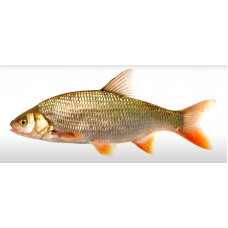The ide (Leuciscus) is a freshwater fish of the Cyprinidae family. Compared to Rutilus rutilus, it has finer scales and a greenish-yellow iris. It reaches a length of 70 cm and a weight of 7-8 kg. It prefers shallow, calm rivers and is common in reservoirs. It matures between the fourth and sixth year of life. The fecundity ranges from 20 to 115 thousand eggs, hatched in spring, April-May, at a shallow depth of 0.6-0.8 m, at a water temperature of 3-4 °C, on the vegetation flooded the previous year. It feeds on benthic organisms and juvenile fish. It is of commercial importance in Ob, Yenisey, Irtysh and many other lakes. The domesticated form - orpha is bred in ponds.
Adults typically reach a length of 35 to 53 cm and a weight of 2 to 2.8 kg, although some can reach up to 90 cm in length and 6 to 8 kg in weight. Lives from 15 to 20 years. The body is thick. The head is shortened and the mouth is small and slanted. The differences may be more or less marked depending on the place, age and season. In spring, the body has a metallic sheen: the gill covers, i.e. the "cheeks", and the head appear golden; when the fish turns towards the sun, the colours change rapidly, becoming golden, then silver, then almost dark; the lower fins, and sometimes the upper fins and tail, are reddish. Back bluish black, sides of body whitish, belly silver, caudal and dorsal fins dark, lower and lateral fins red. Eyes are greenish-yellow or yellow with a dark spot above. Juveniles are lighter and more silvery, fins much paler than adults.
Widespread to a greater or lesser extent in all European countries, absent only in southern and south-eastern Europe (from eastern France), and also in most of Siberia as far as Yakutia. Occurs in the rivers of the Black Sea basin, from the Danube to the Kuban (absent in the Crimea), and in the northern part of the Caspian basin in the Volga, Ural and Emba rivers. Introduced to North America, where it is established in Connecticut in the United States.
It avoids mountainous, very fast and cold rivers, preferring deeper rivers with more moderate currents, river ponds and flowing lakes. It is one of the most hardy fish and can easily tolerate sudden changes in temperature and, to a certain extent, water pollution without adverse effects.
Fish are omnivorous; they feed on plant and animal matter, including insects, especially their larvae, molluscs, worms and higher aquatic vegetation. They feed by moving to places with strong currents. They feed at dusk and at night.
Ide
Tags: ide



